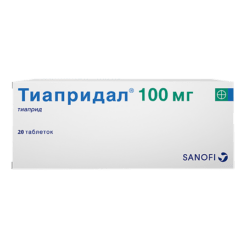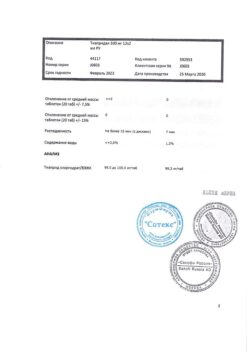No products in the cart.
Tiapride, 5%, 2 ml, 10 pcs.
€1.00
Out of stock
(E-mail when Stock is available)
Description
Antipsychotic (neuroleptic); has sedative, sedative, analgesic effects.
It eliminates dyskinesias of central origin.
It has a pronounced analgesic effect on both interoceptive and exteroceptive pain.
Antipsychotic effect is caused by blockade of dopamine D2-receptors in mesolimbic and mesocortical system.
Sedative action is caused by blockade of adrenoreceptors of reticular formation of brain stem;
antiemetic effect is caused by blockade of dopamine D2 receptors of the trigger zone of the vomiting center;
Hypothermic effect is caused by blockade of dopamine receptors of hypothalamus.
Indications
Indications
Agitation, aggression, especially in chronic alcoholism, in the elderly; resistant to therapy, severe pain syndrome; chorea, tics in Tourette’s disease, severe behavioral disorders accompanied by aggression and agitation.
Active ingredient
Active ingredient
Composition
Composition
In 1 ampoule contains:
Active substance:
thiapride hydrochloride – 111.1 mg (in terms of thiapride -100 mg);
Auxiliary substances:
sodium chloride,
water for injection.
How to take, the dosage
How to take, the dosage
The drug can be given intramuscularly or intravenously and is intended for adults only.
The lowest effective dose should always be chosen. If the patient’s condition allows, treatment should start with a low dose, then gradually increase it.
Treatment of psychomotor agitation and aggressive states, especially in chronic alcoholism or elderly patients
In adults with normal renal function
The usual dose is 200 – 300 mg/day.
In special cases with delirium or pre-delirium: 400 – 1200 mg/day (up to a maximum of 1800 mg/day). The daily dose is divided into 4-6 injections.
In elderly patients
200 – 300 mg/day, the daily dose is divided into 2 – 3 injections.
A single dose of more than 100 mg is not recommended.
Persistent intense pain syndrome
The usual dose is 200 – 400 mg/day, that is 2 – 4 ampoules per day.
Patients with impaired renal function
In patients with renal impairment, the excretion of thiapride correlates with creatinine clearance. Therefore, in creatinine clearance 30-60 ml/min, the dose is reduced by 25%, in creatinine clearance 10-30 ml/min, the dose is reduced by 2 times, in creatinine clearance less than 10 ml/min, the dose is reduced by 4 times compared to doses in normal renal function.
Patients with impaired hepatic function
The drug is slightly metabolized, no change in dosing regimen is required.
Interaction
Interaction
Concomitant use of CNS depressants (including opioid analgesics, antihistamines, barbiturates, benzodiazepines) may increase the CNS depressant effect.
In concomitant use of antihypertensive agents may increase the hypotensive effect.
Special Instructions
Special Instructions
Particular caution is used in patients with epilepsy due to possible lowering of the seizure threshold.
Perhaps with caution in severe cardiovascular disease, parkinsonism, renal failure, and in elderly patients.
Parenteral administration should be under the control of a physician.
Levodopa, dopamine receptor agonists (amantadine, apomorphine, bromocriptine, cabergoline, entacapone, lysuride, pergolide, pyribedil, pramipexole, quinagolide), sultopride should not be used during treatment with tiapride; Drugs that can cause pirouette-type arrhythmias (Class I A and III antiarrhythmic drugs, chlorpromazine, levomepromazine, thioridazine, trifluoperazine, sultopride, Droperidol, haloperidol, pimozide, bepridil, cisapride, difemanil, IV erythromycin, IV vincamine, and halofantrine, morfloxacin, pentamidine, sparfloxacin).
Do not drink alcohol.
Influence on the ability to drive and operate machinery
With caution, use in patients whose activities require concentration and high speed of psychomotor reactions.
Contraindications
Contraindications
Presence or suspicion of prolactin-dependent tumors, pheochromocytoma; hypersensitivity to thiapride.
Side effects
Side effects
CNS side:drowsiness, sleep disturbances, agitation, insomnia, dizziness, headaches, parkinsonism syndrome; rarely – spastic torticollis, oculogyric crises, akathisia, tardive dyskinesia; in some cases – MNS.
Endocrine system disorders: rarely – symptoms due to hyperprolactinemia (amenorrhea, galactorrhea, breast enlargement, mammary gland pain, impotence, disorders of achieving orgasm.
Cardiovascular disorders:increased QT interval, orthostatic hypotension; in some cases – pirouette-type arrhythmias.
Overdose
Overdose
Symptoms:over sedation, somnolence, depression of consciousness up to coma, arterial hypotension, extrapyramidal symptoms.
treatment:discontinuation of the drug, symptomatic and detoxification therapy, monitoring of vital body functions (especially cardiac activity (risk of QT interval prolongation and ventricular rhythm disturbances) until symptoms of intoxication completely disappear. If severe extrapyramidal symptoms occur, use anticholinergic agents.
Because thiapride is poorly dialyzed, hemodialysis is not recommended for its removal from the body.
Tiapride has no specific antidote.
Similarities
Similarities
Additional information
| Shelf life | 5 years. |
|---|---|
| Conditions of storage | Store at a temperature not exceeding 25 ° C. |
| Manufacturer | Organika, Russia |
| Medication form | solution for injections and infusions |
| Brand | Organika |
Other forms…
Related products
Buy Tiapride, 5%, 2 ml, 10 pcs. with delivery to USA, UK, Europe and over 120 other countries.
















